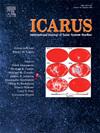耶泽罗陨石坑西扇的矿物组成:Perseverance/SuperCam近红外观测的多高斯建模及主要单元概述
IF 2.5
2区 物理与天体物理
Q2 ASTRONOMY & ASTROPHYSICS
引用次数: 0
摘要
通过对火星耶泽罗陨石坑内岩石的矿物学成分的分析,可以重建该地区在火星早期形成的水活动历史。毅力号火星车搭载的IRS/SuperCam仪器可以通过近红外反射光谱观测到许多由水蚀变产生的次生矿物,以及一些原生矿物。这些矿物的特征,它们在地质单元中的分布,以及它们组合的组成,对于破译耶泽罗陨石坑的化学、气候和地质历史至关重要。为了系统地研究仪器收集的越来越多的红外光谱,我们开发了一种自动提取吸收带特征的方法,基于高斯曲线组合建模(MultiGM)。将这种方法应用于整个IRS数据集,揭示了分布在整个漫游器穿越过程中的矿物的显著多样性,基岩中几乎系统地存在层状硅酸盐,以及三角洲上日益频繁出现的碳酸盐,特别是在边缘单元内。这些碳酸盐表现出不同的2.5 μm波段,这归因于不同的铁和镁成分。三角洲前缘是唯一富含Fe/Mg硫酸盐的单元(Yori Pass/Hogwallow Flats),并伴有玄武岩(水合CaSO4)的出现,而其他三角洲单元和火山口底部的硫酸盐则较为零散,与裂缝/囊泡充填相对应。最后,几乎所有IRS/SuperCam分析的岩石都明显以层状硅酸盐特征(铁/镁蒙脱石,蛇纹石)为主,除了少数露头盖在三角洲上。这种层状硅酸盐的存在证明了耶泽罗岩石的广泛的表面(蒙脱石)和热液(蛇纹石)水蚀变,无论是在原位还是从分水岭携带。本文章由计算机程序翻译,如有差异,请以英文原文为准。
The mineralogical composition of Jezero Crater Western Fan: Multigaussian modeling of Perseverance/SuperCam near-infrared observations and overview of major units
The analysis of the mineralogical composition of rocks within the Jezero crater, Mars, enables the reconstruction of the aqueous activity history of the site, formed during the planet’s early epochs. Numerous secondary minerals resulting from aqueous alteration, as well as some primary minerals, are observable through near-infrared reflectance spectroscopy, as performed by the IRS/SuperCam instrument onboard the Perseverance rover. The characterization of these minerals, their distribution within geological units, as well as the composition of their assemblages, is crucial for deciphering the chemical, climatic, and geological history of the Jezero crater. In order to systematically study the growing number of IR spectra collected by the instrument, we have developed an automated method for extracting the characteristics of absorption bands, based on their modeling using a combination of Gaussian curves (MultiGM). The application of this method to the entire IRS dataset reveals a significant diversity of minerals distributed throughout the rover traverse, with a near-systematic presence of phyllosilicates in bedrocks, as well as increasingly frequent occurrences of carbonates on the delta, particularly within the Margin unit. These carbonates exhibit variable 2.5 m band positions attributed to different Fe and Mg compositions. The delta front presents the sole unit generally enriched in Fe/Mg sulfates (Yori Pass/Hogwallow Flats) accompanied by occurrences of bassanite (hydrated CaSO4), whereas the presence of sulfates in other delta units and the crater floor is more sporadic and corresponds to fracture/vesicle fills. Finally, almost all the rocks analyzed with IRS/SuperCam are notably dominated by phyllosilicates signatures (Fe/Mg-smectites, serpentine), excepted for a few outcrops caping the Delta. This phyllosilicate presence witnesses the extended surficial (smectites) and hydrothermal (serpentine) aqueous alteration of Jezero’s rocks, either in situ or carried from the watershed.
求助全文
通过发布文献求助,成功后即可免费获取论文全文。
去求助
来源期刊

Icarus
地学天文-天文与天体物理
CiteScore
6.30
自引率
18.80%
发文量
356
审稿时长
2-4 weeks
期刊介绍:
Icarus is devoted to the publication of original contributions in the field of Solar System studies. Manuscripts reporting the results of new research - observational, experimental, or theoretical - concerning the astronomy, geology, meteorology, physics, chemistry, biology, and other scientific aspects of our Solar System or extrasolar systems are welcome. The journal generally does not publish papers devoted exclusively to the Sun, the Earth, celestial mechanics, meteoritics, or astrophysics. Icarus does not publish papers that provide "improved" versions of Bode''s law, or other numerical relations, without a sound physical basis. Icarus does not publish meeting announcements or general notices. Reviews, historical papers, and manuscripts describing spacecraft instrumentation may be considered, but only with prior approval of the editor. An entire issue of the journal is occasionally devoted to a single subject, usually arising from a conference on the same topic. The language of publication is English. American or British usage is accepted, but not a mixture of these.
 求助内容:
求助内容: 应助结果提醒方式:
应助结果提醒方式:


